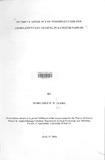Nutrient Adequacy Of Porridges Used For Complementary Feeding In Kangemi-Nairobi

View/
Date
2004-08Author
Aleke, Margaret P. W.
Type
ThesisLanguage
enMetadata
Show full item recordAbstract
The main objective of the study was to investigate the nutrient adequacy of porridges used for complementary feeding among children aged 6-24 months in Kangemi. To achieve the objective, the types of porridges consumed, levels and patterns of their consumption, preparation methods and nutrient (energy, protein, calcium, iron, zinc and vitamin A) content were determined. The extent of use of the porridges by mothers, the proportions of nutrients contributed by porridges to the daily dietary intake and storage practices were also examined.
Using a purposive and systematic sampling procedure, 144 children aged 6-24 months and their mothers were identified and interviewed. A cross-sectional descriptive and analytical study was carried out using structured and pre-tested questionnaires, and focus group discussions. Information was sought on feeding frequency, composition of porridge flours, types and amounts of ingredients used in preparation of complementary foods (including porridges), the amounts consumed by the child in 24 hours, hygienic practices and illnesses.
The main findings were that the porridges were only adequate in protein but not in energy, calcium, iron, zinc and vitamin A. They were made from raw-dry-whole milled grains (millet, sorghum and/or maize, beans and soybeans) with or without enrichment with sugar, milk and/or margarine. The enrichment of porridges with other foods improved nutrient concentration, but their bioavailability was uncertain.
xiii
]t is recommended that, nutrition guidelines be reviewed to cover existing technologies, update nutrition knowledge of health workers and, sensitise mothers and millers on the nature of porridges. They should be sensitised and encouraged to use simple technologies such as soaking, roasting and fermentation and, addition of amylases, micronutrient rich foods to improve nutrient density and bioavailability, and on the need to sustain breastfeeding to supplement porridge. Further research is required to validate nutrient content of the porridges; determine optimum cooking times and; appropriate flour formulations that provide minimum composition of nutrients to meet the RDAs for energy, protein, calcium, iron, zinc and vitamin A. It was also recommended that the necessary national standards for monitoring the quality of the flour formulations be developed
Publisher
University of Nairobi
